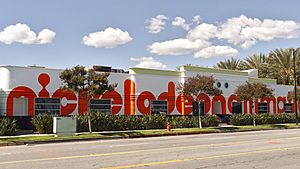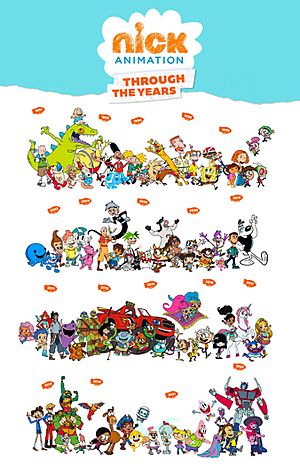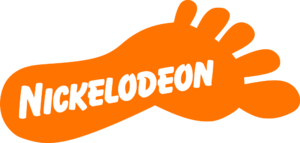Nickelodeon Animation Studio facts for kids

Logo used since 2016
|
|

The Nickelodeon Animation Studio on Olive Avenue in Burbank, California
|
|
|
Formerly
|
Games Animation (1992–1998) |
|---|---|
| Subsidiary | |
| Industry | Animation |
| Predecessor | Spümcø (1989–1992) |
| Founded | 1992 |
| Founders |
|
| Headquarters | Studio City, Los Angeles, California, U.S. (1992–1998) Burbank, California, U.S. (1998–present) New York City, New York, U.S. (second facility, 1999–present) |
|
Key people
|
Ramsey Ann Naito (president) |
| Products | |
| Parent | Nickelodeon Group |
| Divisions |
|
Nickelodeon Animation Studio Inc., also known as Nick Animation, is an American animation studio. It is part of the Paramount Skydance Corporation through the Nickelodeon Group. This studio creates many original animated TV shows for Nickelodeon, Nicktoons, and Nick Jr.
Some of its most famous shows include SpongeBob SquarePants, The Fairly OddParents, Rugrats, Avatar: The Last Airbender, and The Loud House. Since the 2010s, the studio has also made shows based on popular characters it bought. These include Teenage Mutant Ninja Turtles and Winx Club. In 2019, Nickelodeon Animation Studio started making content for Netflix and Paramount+. This includes both new and existing shows.
The studio began in 1992 as Games Animation Inc. It was a part of a company called Games Productions. This company is now known as Nickelodeon Productions. Games Animation helped make early Nickelodeon shows like Doug, Rugrats, and The Ren & Stimpy Show. In 1992, the studio started its first fully in-house show, Rocko's Modern Life. In 1998, the studio moved to a new building in Burbank, California. It was then renamed Nickelodeon Animation Studio. A second studio opened in New York City in 1999.
Contents
The Studio's History
How Nick Animation Started (1990–1998)
Nickelodeon Animation Studio began when Nickelodeon wanted to create its own animated shows, called Nicktoons. In 1990, Nickelodeon hired Vanessa Coffey. Her job was to find new characters and stories for the channel. Nickelodeon wanted to find talented cartoonists. They were inspired by early animation artists.
Nickelodeon decided to fund eight short pilot episodes. Each pilot cost $100,000. From these, three shows were chosen: Doug, Rugrats, and The Ren & Stimpy Show. These early Nicktoons were made by outside studios. Nickelodeon oversaw their production.
In 1992, Nickelodeon had some creative disagreements with the studio making The Ren & Stimpy Show. Nickelodeon decided to move the show's production in-house. They used a company they already owned called Games Productions Inc. Games Animation was set up as a part of this company in 1992. The show continued under new creative leaders.
Games Animation was first located in Studio City, California. In 1992, animator Joe Murray was asked to create a new show. This show became Rocko's Modern Life. It was the first show fully made by Games Animation. The show premiered in 1993 and employed over 70 people. Rocko's Modern Life ended in 1996.
Games Animation also stopped working on Doug. Nickelodeon's parent company sold the rights to Doug to another company in 1994. This meant Games Animation would have full control over future shows they produced. After Rocko's Modern Life ended, Games Animation made pilot episodes for Hey Arnold!, The Angry Beavers, and CatDog.
Becoming Nickelodeon Animation Studio (1998–2007)
In 1996, Nickelodeon's president, Albie Hecht, met with artists. They brainstormed ideas for their perfect animation studio. They wanted a fun and inspiring place. Hecht hoped this new studio would create the next generation of classic cartoons.
The new studio opened on March 4, 1998, in Burbank, California. It was a large building with space for 200–300 employees. It could work on up to five shows at once. The studio had fun features like a miniature golf course and a basketball court. It also had an artists' gallery and a fountain with green water. Each production team had its own colorful area. The studio also had special rooms for sound and editing.
In September 1999, Nickelodeon opened another animation studio. This one was in New York City. The New York studio mainly focused on animated shows for Nick Jr..
In 2006, Nickelodeon started working with DreamWorks Animation. They planned to create shows based on DreamWorks movies. The first show from this partnership was The Penguins of Madagascar. It premiered in 2008. Other shows followed, like Kung Fu Panda: Legends of Awesomeness.
New Shows and Studio Growth (2009–2019)
In 2007, Nickelodeon launched El Tigre: The Adventures of Manny Rivera. This was the first Nicktoon made using Adobe Flash. They also released Tak and the Power of Juju, based on a video game. These shows showed Nickelodeon was open to working with many different companies.
In 2009, Nickelodeon bought the rights to Teenage Mutant Ninja Turtles. In 2011, Nickelodeon's parent company bought part of an Italian studio called Rainbow S.p.A., which created Winx Club. After these purchases, Nickelodeon Animation Studio began making new shows for both franchises. They created a continuation of Winx Club and a new TMNT series. Nickelodeon considers these new shows official Nicktoons.
By 2013, the deal with DreamWorks Animation ended. Nickelodeon wanted to focus on creating more original shows. So, Nickelodeon Animation Studio started the Nickelodeon Animated Shorts Program. This program created new animated short films. Some of these shorts were later turned into full TV shows.
In 2016, Nickelodeon's Burbank animation studio moved to a new, larger building. This move brought many animated productions together in one place. Because this new location houses both animated and live-action shows, it is now simply called "Nickelodeon Studios." The famous Nickelodeon time capsule, which was buried in 1992, also moved to this new studio. The capsule is set to be opened on April 30, 2042. The new studio officially opened on January 11, 2017.
Expanding Popular Shows (2019–Present)
In 2018, Brian Robbins became the president of Nickelodeon. In 2019, he appointed Ramsey Ann Naito to lead animation at Nickelodeon. She was later promoted to president of Nickelodeon Animation Studio in 2020. Under Robbins' leadership, Nickelodeon focused on expanding its popular shows.
Nickelodeon Animation Studio began making new versions and spin-offs of classic shows. These included Rocko's Modern Life: Static Cling and Invader Zim: Enter the Florpus for Netflix. They also made a new computer-animated Rugrats series for Paramount+. The first-ever SpongeBob spin-offs, Kamp Koral: SpongeBob's Under Years and The Patrick Star Show, were also produced.
The studio also worked with CBS Eye Animation Productions to create Star Trek: Prodigy. In 2021, Avatar Studios was launched. This is a special division of Nickelodeon Animation. It focuses on making projects from the Avatar: The Last Airbender world. In 2023, the studio made a deal with Lion Forge Entertainment to create more animated series and movies.
Filmography
See also
 In Spanish: Nickelodeon Animation Studio para niños
In Spanish: Nickelodeon Animation Studio para niños
- List of animation studios owned by Paramount Global
- Nickelodeon Movies
- Paramount Animation – animation division of Paramount Global's film studio, Paramount Pictures
- MTV Animation – animation division of fellow Paramount Global's MTV Entertainment Studios
- CBS Eye Animation Productions – the animation division of CBS Studios
- Rainbow S.p.A. – Italian animation studio co-owned by Paramount Global from 2011 until 2023



